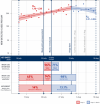Grist for the mill ... New study looking at the impact of a mandatory mask policy on Melbourne's outbreak last year:
https://journals.plos.org/plosone/article?id=10.1371/journal.pone.0253510
(Recalling that Melbourne managed to get cases from a daily peak of ~700 down to a sustainable zero over the course of a couple of months.)
Conclusion: The study estimates the mask mandate, independently of other measures, reduced Reff from ~1.2 to ~0.9. In other words, to a level where the outbreak was diminishing.
Obviously, how convincing you find this
should depend on yr assessment of the quality of the methods, but
in fact will probably depend on yr priors
🙂
View attachment 18039
Background
Whilst evidence of use of face masks in reducing COVID-19 cases is increasing, the impact of mandatory use across a large population has been difficult to assess. Introduction of mandatory mask use on July 22, 2020 during a resurgence of COVID-19 in Melbourne, Australia created a situation that facilitated an assessment of the impact of the policy on the epidemic growth rate as its introduction occurred in the absence of other changes to restrictions.
Methods and findings
Exponential epidemic growth or decay rates in daily COVID-19 diagnoses were estimated using a non-weighted linear regression of the natural logarithm of the daily cases against time, using a linear spline model with one knot (lspline package in R v 3.6.3). The model’s two linear segments pivot around the hinge day, on which the mask policy began to take effect, 8 days following the introduction of the policy. We used two forms of data to assess change in mask usage: images of people wearing masks in public places obtained from a major media outlet and population-based survey data. Potential confounding factors (including daily COVID-19 tests, number of COVID-19 cases among population subsets affected differentially by the mask policy–e.g., healthcare workers) were examined for their impact on the results. Daily cases fitted an exponential growth in the first log-linear segment (k = +0.042, s.e. = 0.007), and fitted an exponential decay in the second (k = -0.023, s.e. = 0.017) log-linear segment. Over a range of reported serial intervals for SARS-CoV-2 infection, these growth rates correspond to a 22–33% reduction in an effective reproduction ratio before and after mandatory mask use. Analysis of images of people in public spaces showed mask usage rose from approximately 43% to 97%. Analysis of survey data found that on the third day before policy introduction, 44% of participants reported “often” or “always” wearing a mask; on the fourth day after, 100% reported “always” doing so. No potentially confounding factors were associated with the observed change in growth rates.
Conclusions
The mandatory mask use policy substantially increased public use of masks and was associated with a significant decline in new COVID-19 cases after introduction of the policy. This study strongly supports the use of masks for controlling epidemics in the broader community.


